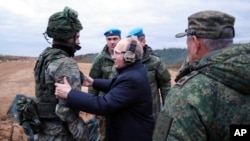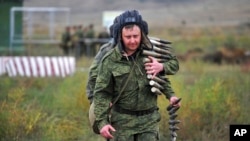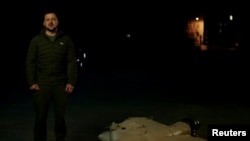Russian Defense Minister Sergei Shoigu on Friday said Russia had completed the mobilization of 300,000 reservists drafted to fight in Ukraine, and that 82,000 of those conscripted already had been sent to the front and another 218,000 were in “combat training.”
The announcement, made during a televised meeting at the Kremlin, ostensibly concluded the divisive mobilization drive in Russia, the first since World War II. The draft prompted thousands of men to flee Russia and fueled anti-war protests in the country.
Meanwhile, the Pentagon announced Friday that it would provide $275 million in additional military assistance to Ukraine. Sabrina Singh, the Pentagon’s deputy press secretary, said the package would include HIMARS ammunition, hundreds of 155mm precision-guided artillery rounds, remote anti-armor mine systems, armored vehicles and small arms.
Ukrainian gunners are facing ammunition shortages on the battlefield in areas stretching from Mykolaiv to Kherson. “For every one shell that we send, they [Russians] send back five,” Hennadyi, a Ukrainian gunner, told a Reuters reporter.
According to the general staff of Ukraine’s armed forces on Friday, Russian forces had shelled 30 settlements in the Kharkiv, Donetsk, Kherson and Mikolaiv oblasts. The governor of Luhansk said Friday that Ukrainian troops were largely in control, though, of a key road that links two Russian-occupied districts in the east of the country.
Ukrainian troops are slowly pushing eastward into the Luhansk region, aiming to take the Russian-occupied towns of Svatove and Kreminna, 45 kilometers to the south. The towns are the primary settlements in districts with the same names.
"The road from Svatove to Kreminna is practically under the control of the armed forces of Ukraine. Our soldiers are advancing daily," Serhiy Gaidai, governor of the Luhansk region, said on national television.
In other news, during a phone call with his Iranian counterpart Hossein Amirabdollahian on Friday, Ukraine’s Foreign Minister Dmytro Kuleba demanded that Tehran stop sending kamikaze drones to Russia. The drones have been used by Russia forces to target Ukrainian infrastructure. Iran denies the charge.
European ‘crisis’
Elsewhere Friday, German President Frank-Walter Steinmeier warned of “tougher, rough years ahead,” for his country and Europe.
In an address dubbed a "state of the nation" speech, the German president said the war in Ukraine had led to “the deepest crisis” in a reunified Germany. He pointed to an energy crunch, soaring costs of living and increasing poverty rates.
“This crisis demands that we learn to be modest again," Steinmeier said during the speech at his official residence, Bellevue Palace, in Berlin. He pledged Germany’s commitment to support Ukraine and its partnership with NATO and European Union allies.
In his daily address to the nation on Friday, Ukrainian President Volodymyr Zelenskyy, standing by what appeared to be a downed drone, said “the aggressor [Russia] continues his terror. We are again attacked from the sky by a flock of their crows.”
“More than 30 drones were launched in two days,” the president said. “The defenders of our sky prevented the enemy's vultures from breaking into the rear of the country and downed 23 Shaheds [Iranian drones]. In addition, the Kh-59 guided air missile, two Ka-52 attack helicopters and another Su-25 attack aircraft were turned into scrap metal.”
Zelenskyy said that during this time period, “Russia carried out 4,500 missile strikes and more than 8,000 air raids. But we are fighting; we will shoot down more.”
It was not immediately clear if there had been any casualties.
In his speech, the Ukrainian president marked the anniversary of the liberation of Ukraine from the Nazi Germany in 1945, and he paid tribute to the Ukrainians who fought and defeated Nazism in 1945 as he pledged to expel Russia from Ukraine.
Britain’s Defense Ministry delivered a report Friday on Russia’s capabilities in Ukraine. In the report posted on Twitter, the ministry said some Russian units in Ukraine had been manned with mobilized reservists and that the units were understaffed.
“In September 2022, Russian officers described companies in the Kherson sector as consisting of between six and eight men each. Companies should deploy with around 100 personnel,” the update said.
The update said Russian ground forces in Ukraine were transitioning to “a long-term, defensive posture on most areas of the front line in Ukraine ... likely due to a more realistic assessment that the severely undermanned, poorly trained force in Ukraine is currently only capable of defensive operations.”
'Dirty bomb'
Director General Rafael Grossi of the International Atomic Energy Agency said Thursday that inspectors were to arrive and start working within a couple of days at two facilities in Ukraine that Russia alleged were diverting nuclear material to make a "dirty bomb."
"I had a very comprehensive discussion with [Ukrainian] Foreign Minister Kuleba about this," Grossi told reporters at the United Nations in New York. "He came to the conclusion, and I agreed, that the best way to dispel any doubt is to allow the inspectors in."
For several days, Russian officials have alleged without evidence that Ukraine is planning to develop and use a so-called dirty bomb in its conflict with Russia. Ukraine and its Western allies have strongly denied the allegations and suspect they are being made as a pretext for some type of escalation in the war in Ukraine, possibly a "false-flag" operation by Moscow.
Dirty bombs combine conventional explosives with radioactive material and are designed to spread radioactivity that can cause death and contamination.
"In this case, there has been a very clear indication from a very high official of the Russian Federation about work — clandestine work, in fact — to divert nuclear material," the IAEA chief told reporters after he met privately with the U.N. Security Council.
He said IAEA inspectors would be looking to see if fuel at the facilities had been reprocessed in some way to extract two isotopes — caesium and strontium — that are used in making radiological bombs.
VOA National Security Correspondent Jeff Seldin and U.N. Correspondent Margaret Besheer contributed to this report. Some information came from The Associated Press, Agence France-Presse and Reuters.













